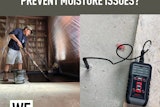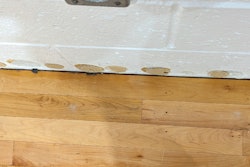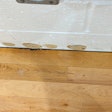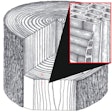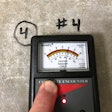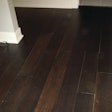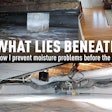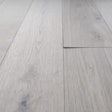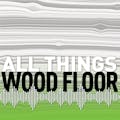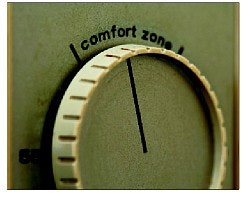
In the last 50 years or so, cooling has become widespread. Much more recently, we've put effort into intentionally controlling humidity in buildings. The American Society of Heating, Refrigeration and Air Conditioning Engineers (ASHRAE) has published "acceptable" indoor conditions that range near 70 to 75 degrees Fahrenheit (F) and 30 to 50 percent relative humidity (RH). These conditions guide us in determining the expected in-use moisture content of wood flooring.
Wood flooring reacts to the environment it is in. Wood gains or loses moisture and correspondingly gets bigger or smaller based on the moisture content and temperature of its surroundings. Everyone involved with wood deals with this wood-moisture-temperature phenomenon. NOFMA, the NWFA, the U.S. Forest Products Lab and even other publications like Fine Woodworking publish information on these relationships and how to deal with them. We, as flooring professionals, need to know what determines or affects humidity and temperature levels in a house, and how those interactions affect wood floors. Here are some basics every wood flooring professional should know.
Moist Air Relationships
Air as we know it contains moisture in the form of water vapor. This air has a temperature and relative humidity. The relationship between temperature and relative humidity is covered in an area of physics and engineering called psychrometrics (pronounced sigh-crow-met-ricks), or the thermodynamic properties of air.
According to psychrometrics, air at a given temperature can only hold a given amount of moisture. Warm air can hold more moisture than cold air. The ratio of how much moisture is in the air compared to how much it can hold at a given temperature is defined as relative humidity. Relative humidity is expressed as a percent (%) and is abbreviated as RH. Air at 50% RH contains half of the moisture the air can hold at that temperature.
Heating or cooling air doesn't change the amount of moisture in the air, but it does change the air's capacity to hold moisture. (Air conditioners as dehumidifiers are discussed later.) For example, air at 95 degrees F can hold twice as much moisture as air at 75 degrees F. So, changing the temperature of air changes the RH because the capacity changes, but the actual amount of moisture doesn't. This is a critical concept: Changing the temperature of air changes its RH. Say it out loud three times: Changing the temperature of air changes its relative humidity. (See the sidebar "Temperature and Relative Humidity" at the end of this article.)
As air is cooled, its capacity to hold moisture decreases. At a temperature, called the dew point, the air becomes saturated and can't hold any more moisture. Cooling the air below the dew point causes the water vapor to become liquid, forming dew or condensation.
In a general sense, outside air in the early morning is saturated and at dew point (100% RH). This is why we get dew on windshields and grass. As the sun heats the air, the RH decreases, and by late afternoon, the outside air is usually at the lowest RH of the day. All day long, the dew point is pretty much the same. The temperature changes and, therefore, the RH changes.
Adding or removing moisture can also change the RH. Humidifiers, cooking, bathing and cleaning activities are ways to add moisture to air. Dehumidifiers and air conditioners are typical ways to remove moisture and lower RH.
So when we change the temperature in a building, we can affect the wood floor because of a related change in RH.
RELATED: How to Prevent Wood Floor Gaps in Winter
Buildings Need Air
Some outside air is necessary to keep people comfortable and healthy. Ventilation occurs both through unplanned openings such as cracks and joints around doors and windows and through planned openings such as exhaust fans and mechanical ventilation systems. (Ventilation through unplanned openings is often called infiltration, but here we will call it all ventilation.)
House ventilation is measured in air changes per hour (ACH), or how many times the entire volume of air in the house would change in an hour. For example, a 1,000-square-foot house with 8-foot-tall ceilings would have a volume of 8,000 cubic feet. One air change per hour means 8,000 cubic feet of outside air would move through this house in one hour. Mechanical ventilation systems, such as exhaust fans, are rated in cubic feet per minute (CFM).
A modern "tight" house may have a ventilation rate of less than one-third air change per hour. An older "leaky" house may have two to three or more air changes per hour. I've seen houses with ventilation rates of more than 10 air changes per hour.
Leaky houses can have large swings in humidity levels and corresponding large energy bills. Large swings in humidity levels translate into lots of movement in wood floors.
Winter Leaks
In Albany, N.Y., for example, 20-degree-F outside air at 100% RH leaking into a 70-degree-F house will become about 12% RH air. What will that do to flooring? In actuality, the air usually mixes rapidly with household moisture and doesn't hit these extremes. But in localized spots or over the long term, very dry spots can happen.
Adding moisture to the air can help keep the RH up. Leaky houses require more moisture. In our 1,000-squarefoot house under the 20 degrees F and 100% RH outside conditions, psychrometrics indicates that we would have to add 1.5 pounds of water per ACH just to get to 25% RH in the house. In a tight house with one-third ACH, we could add only 0.5 pound of water per hour. In a leaky house with 5 ACH, we would need 7.5 pounds of moisture per hour.
How do we add that kind of moisture? The house and its contents contain enough water to provide a short-term buffer to keep things from getting too dry. People, plants, pets, bathing, cleaning and cooking activities all add some moisture. In some climates, humidifiers are common when other internal moisture sources cannot provide the necessary moisture.
Summer Leaks
In cooling climates, the opposite happens. As air leaks in and is cooled, its RH goes up. As a result, boards get bigger, gaps close or cupping occurs. In some cases, the leaking air condenses on cold surfaces and creates water issues similar to flooding and plumbing leaks.
Air conditioners can remove moisture from the air and help control indoor humidity levels. But typical air conditioners are controlled by temperature settings, not humidity levels. Short run times, leaky buildings and excess moisture sources can all cause summer indoor humidity levels to be high. For example, outside summer air in Charleston, S.C., is near 95 degrees F and 50% RH. When this air leaks in and is cooled to 75 degrees F, the RH jumps to 100%. Again, dilution and removal don't let it normally get this high. But localized leakage spots and cold spots can.
Removing moisture from the inside air helps keep the humidity at respectable levels of 40 to 50% RH. To dry one ACH of 95 degree F and 50% RH air in our 1,000-square-foot house to 50% RH requires the removal of about 5 pounds of water per hour. A 2-ton air conditioner would remove about 6 pounds per hour, running continuously. So on a hot afternoon, with a mildly leaky house, we can maintain a respectable 50% RH. If the house is leakier, the AC can easily be overwhelmed, resulting in higher inside humidity levels. An equally common situation is when the AC is oversized. Oversizing shortens run time and, therefore, dehumidification capabilities. Even a properly sized AC is oversized most of the time. In the above example, early morning temperatures in Charleston could be near 75 degrees F, with a RH near 100%. With 75 degrees F outside and a thermostat setting of 75 degrees F inside, the AC will run very little. Yet the moisture load is the same, so we still need to remove those 5 pounds of water per hour, or the RH will go up. Leakier houses would again be worse.
RELATED: How to Prevent Cupping and Worse in Summer Months
Air/Floor Relationships
A wood floor is affected by the air immediately next to it, not feet or even inches away. The environment above the floor is typically conditioned space controlled to make the majority of people comfortable in an indoor situation.
In above-floor spaces, the air near the floor is often different from that in the center of the room or even on a table in the same room. In buildings with radiant-heated floors, wall radiators or other nonforced air-heating systems, floor temperatures may be several degrees different from those in the middle of the room. In buildings with windows, solar gain can affect floor temperatures. Therefore, best practices dictate that the conditions at the floor are the important ones. Remember the psychrometrics: change the temperature and you change the RH.
When you have concerns about flooring in a particular area, measure the conditions of that flooring. If you are concerned with gaps in front of a window, measure the temperature and RH at the flooring in front of the window. Say out loud three times: "The conditions at the floor are the important ones."
Subfloor Dynamics
The environment under the floor can also affect wood flooring. Under-floor environments range from fully conditioned spaces (like a first story), semiconditioned spaces (like a basement), unconditioned spaces (like a crawlspace) and slabs that are on-grade. These spaces and systems are governed by the same psychrometrics and moisture dynamics as the spaces above the floors. But because these spaces are conditioned (or not) to a different level from that above the floor, they can affect the flooring from the underside. We see the effects of this kind of situation when wood flooring cups because of a wet slab. Again, the conditions immediately under the floor are the important ones, not the conditions inches or feet away.
Wood flooring installed on a second floor has similar conditioned space above and below. It is controlled by normal swings in indoor environments and settings, and is usually the most stable, predictable flooring in the house. Things can go a little screwy if floor framing consists of open-web floor trusses with leaky band joists. Then the floor environment can become a different environment from the living space.
Floors installed over a basement can be exposed to two different environments. Basements can have cold walls because of earth temperatures, and they can be humid because of water leaks. Basements aren't as well-ventilated as upper floors, so they don't experience the same level of winter drying. Air conditioning needs in basements are minimal because of cool walls, cool floors overhead and even cold ducts. It's no wonder that so many basements have mold problems. And if there is enough moisture for mold, there is potentially enough moisture to affect flooring. One thing in our favor is that heat rises, so floors over basements are usually warmer than the basement in general, so RH levels near the wood floor are lower.
The air in a vented crawlspace is at best just outside air. Any change in temperature between the crawlspace and outside or any gain of moisture in the crawlspace will affect the RH in the crawlspace. In the heating season, crawlspaces are usually warmer than outside. So even if we do gain some moisture from the soil, the air in the crawlspace will be at a lower RH than outside air. In Albany, N.Y., that 20-degree-F outside air at 100% RH leaking into a 50-degree-F crawlspace will push the crawl space toward 25% RH.
RELATED: Wood Floor Cupping: Why Does it Happen & What Can You Do?
Solutions
Wood floors react to an indoor environment in a predictable way because of known relationships with temperature and relative humidity. A more stable environment results in a more stable floor. Wood species, board width and consumer expectations are factors that determine environmental requirements.
One solution to dry or humid houses is to add humidity controls. Humidifiers are added for the heating season to keep things from getting too dry. Dehumidifiers are added or air conditioners are turned down to deal with summer moisture. Constraints to adding moisture are energy requirements and the quantity of water needed in a large or leaky building, and not over-humidifying the inside such that condensation on windows or other building surfaces occurs. Concerns of health issues with dirty or contaminated humidifiers are also an issue.
Air conditioners can help control summer humidity levels but need to run to be effective. AC units typically do not dehumidify much in the morning or during cooler spring and fall seasons when moisture loads can still be high. In many cases, a stand-alone or whole-house dehumidifier is necessary, especially with wider flooring in more humid climates. In this way, humidity levels are controlled independent of temperatures.
Outside air is not the friend of wood flooring. Winter ventilation tends to dry flooring; summer ventilation tends to add moisture to flooring. Beyond what is necessary for human health and safety, more is not better. An effective step in reducing floor issues is to reduce ventilation and air infiltration as much as possible.
The next step is to get the environment across the floor as consistent as possible. Try to eliminate cold spots resulting from AC systems, ducts and registers, and exterior wall drafts. Eliminate hot spots at windows and near heating systems, ducts and registers.
Another step is to get the environment on both sides of the flooring as similar as possible. In under-floor spaces such as crawlspaces, thermal, air and moisture flows need to be addressed. Using insulation incorporating an air and moisture barrier can accomplish this. Separate thermal, air and moisture barriers can also be combined to do the job.
A consistent, stable environment will result in a more stable, consistent wood floor. With today's high consumer expectations and flooring preferences, consistent, stable environments are necessary for a successful wood floor installation. The good news is that creating those environments is quite possible and cost effective. The bad news is that it takes many other building trades to help make it happen.
Temperature and Relative HumidityTemperature affects relative humidity. The following are examples of air that has the same number of water molecules and the same number of air molecules. Only the temperature is different. Cooling the air raises the RH. These are the same air at different temperatures:
Heating the air lowers the RH. These are the same air at different temperatures:
|










